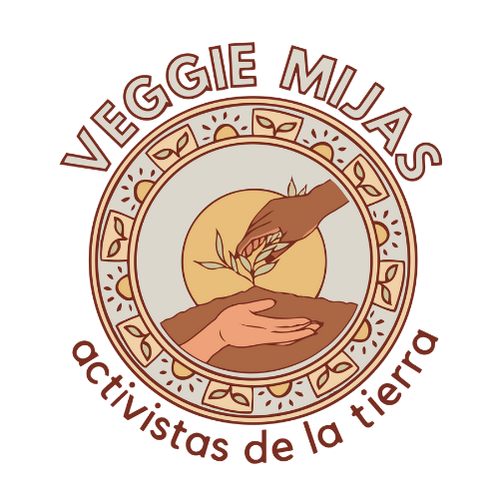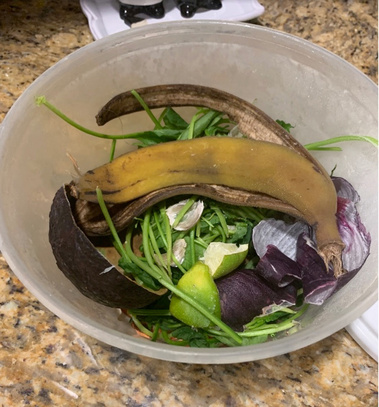* * *
Planeta o Plástico is a segment that highlights low waste living by providing alternatives to the single use consumerism and tips on reducing plastic waste. This segment was created by Emily Lopez, also known as @Eco_Chicana, to rethink the convenience of our plastic use, to inspire POC to live as sustainable as possible, and to reclaim space in a largely white liberal movement.
* * *
Emily Lopez, Los Angeles
"Emily graduated with a bachelors degree in the Environmental Studies in 2015 and started her zero waste journey in 2018 with @Eco_Chicana. Emily uses her instagram platform to document her transition to a zero waste lifestyle: what she eats, consumes, products she uses, and so much more. Although zero waste living is the goal, it is important to remember that everyone's version of low waste living may look differently but all forms of environmentalism are valid."
* * *
Low Waste Grocery Shopping
For most people, the kitchen is where most of our trash comes from, whether its spoiled food, food scraps, or plastic packaging. According to the EPA (Environmental Protections Agency), about 45% of the materials in landfills are either food or packaging/containers. Our grocery shopping habits are the best place to start reducing one of the biggest contributors to landfill waste. The first thing I changed when I decided to go zero waste was how I went grocery shopping. I’ve listed a few things that I try to do/bring:
Low Waste Grocery Shopping Essentials
- Reusable Shopping Bags
- Produce Bags and/or Cotton Drawstring Bags
- Storage Containers
Come Prepared
Bringing your own containers or bags is sometimes the only way to avoid using single-use plastic. Access what you already have at home. I do recommend eventually investing in some reusable cotton drawstring bags because they do save time at the cash register. Try to have containers ready for when you get home from the market so you can easily empty your recently purchased items into these containers and have your bulk bags available for your next shopping trip.
Make the Most of the Bulk Food Section
When referring to bulk food, I don’t mean buying in large quantities. It’s any food that’s sold loose, aka no packaging. Most bulk food sections carry nuts, grains, pastas, beans, spices, etc. If you come prepared with you own bags/containers, you can buy these items completely package-free! I recommend using the bulk finder on Zero Waste Home to find some locations near you.
Don’t forget to write down the food code. You’ll need it to check out. I like to write it down on the actual bag because it’s easier and faster for the cashier.
Avoid Unnecessary Packaging
Supermarkets are starting to use more and more plastic packaging, even for unnecessary items like produce. It’s always better to have a healthy and balanced diet than reduce your plastic waste but when possible, try to purchase package-free items.
If package-free is not an option available to you, remember that not all packaging is created equally. Glass containers can be great because its an easily reusable item and most municipalities will recycle glass because the process won’t degrade the quality of the material; however more energy is needed to produce, recycle, and transport glass when compared to plastic.
Unlike glass, plastic can’t be recycled endlessly because the process reduces the quality of the material so only 9% of all plastic is actually recycled. Also, toxic chemicals in plastic can leach out into food, water, and soil. There’s environmental impacts for everything we purchase, we just have to be conscious of our choices and make the effort to select the least damaging. Try talking to your local recycling center to see what items they accept and make informed decisions.
Shop Local & Organic
Do some research to learn if your community has a local farmer market. One of the benefits of shopping local is that your food has traveled less miles, which means it has a smaller carbon footprint. Don’t assume everything in your farmers market is organic. If you are unsure, always ask!
Organic farming has a lower environmental impact than conventional farming because it avoids synthetic fertilizers, pesticides, and herbicides, among other techniques. These chemicals have entered waterways and increased the nitrogen levels to the point that we have dead-zones in our oceans and harmful drinking water in some areas. Organic food is expensive so don’t feel obligated to buy it if you can’t afford it.
Unfortunately, organic and local foods are not accessible to all communities. For those who can afford and access it, please be conscious of your privilege and avoid paying for cheap food that pushes external costs of production onto marginalized communities. Health-related risks and ecological damage are just a few examples of harmful external costs of conventional farming, which aren’t reflected in its actual price.
It may seem daunting in the beginning but try to start with something that’s easy for you and work from there! I’m very lucky that I live in an area where I can easily access these options but I know not everyone has the means to do so. Don’t feel discouraged if you get some looks or questions when grocery shopping. Zero waste living is not yet commonplace but if we use that curiosity as a teachable moment, we can spread environmental consciousness and normalize this movement!
* * *
The Problem with Food Waste
In the United States alone, we send 25.9 million tons of food waste to our landfills. That’s nearly 25% of all food produced domestically! Without any change, our food waste can lead to permanent environmental damage. But doesn’t food just decompose naturally?
Yes and no. When food waste is sent to landfills, the decomposition process produces methane gas, which traps heat at a rate 23-25 times greater than carbon dioxide. Plus, plastic trash bags “preserve” organic matter, making the decomposition process longer than in nature. So what’s the solution?
Composting is a better alternative because it avoids the release of methane and decreases the effects of climate change. With a compost pile, food and yard waste can decompose aerobically (with oxygen) and the nutrients from the waste can be returned to the soil.
Composting is a science! You have to find the right balance of carbon-rich brown materials - dried leaves, wood chips, etc. - and nitrogen-rich green materials - grass clippings, food scraps, etc. There’s also several compost methods. If you’re interested in composting, here’s more information to get started: Compost Guide
For beginners, I would recommend starting off by collecting food scraps and finding a local community garden or farmers market that has a compost drop-off. I live in a small apartment so I store my compost bin in the freezer to avoid bugs and bad odors.
Every other weekend, I go to the farmers market and bring my food scraps to the LA Compost drop-off. If you live in the LA area, here’s a list of their locations: LA Compost Hubs
ShareWaste is another good resource if you’re looking for a home for your food scraps. It’s an app/website where anyone who wants to receive food scraps or give to a compost pile can find each other.
Food waste and composting is probably the least glamorous part of zero waste living. It’s probably why it took me awhile to make the jump. Now that I’ve been doing it for a few months, I’ve built a routine and I hardly think about it on a day-to-day basis. But it took some time and learning about my options to get to this point. Do some research to see what resources are available in your area and finally break the landfill cycle!
Sources:
Recycle - Compost vs Landfill
Scientific American - Wasteland
* * *
Zero Waste 101
At the start of the year, I stumbled across some people online who were proudly holding up half-empty mason jars to demonstrate their commitment to living zero waste. This was my first introduction to the zero waste movement and I was immediately intimidated. This movement seeks to reduce the waste that gets sent to our landfills, incinerators, and oceans.
I always thought of myself as ‘pro-environment” because I supported environmental protections and renewable energy but I knew that I could be doing a lot more. The growing urgency of climate change motivated me to finally make the transition toward zero waste living. Through my journey, I’ve learned a few things that made my transition smoother.
Focus on One Thing at a Time
There’s no way to avoid the inevitable missteps that happen during the transition to low waste living. I primarily focus on reducing plastic waste because it can take up to 400 years to break down but food, paper, and electronic waste should also be diverted from landfills and incinerators. When I first started, I tried to assess where the majority of your waste was coming from and concentrate on reducing that. For me, it was getting too much take-out. To address it, I started cooking at home more often and buying from the bulk food section. Personalize the methods so that it fits your needs and accessibility.
Use What You Already Have
When I first decided to live zero waste, I thought I had to buy new jars, matching containers, etc. Save your money and try to use whatever you already own, even if it’s made of plastic, to reduce plastic waste sent to landfills. I’ve learned that it's best to wait until the product is almost empty or too worn out before replacing them with sustainable alternatives.
Find a Zero Waste Buddy
Try to find someone to join you and/or understands why you’ve committed to a low impact lifestyle. It can be your family, partner, or roommate. Having a buddy has kept me accountable and their support has reaffirmed my decision. I also feel more comfortable refusing single-use plastic and requesting things in my reusable containers when I have a friend with me.
Zero waste is the goal we should strive for whenever possible rather than an absolute rule. Getting to a completely zero waste lifestyle looks differently for everyone but once you start, it’s hard to go back!
* * *









